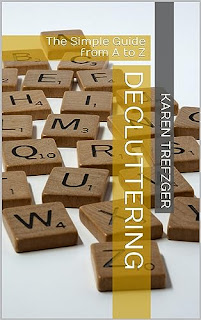This is the Best Place to Start When You're Overwhelmed by Clutter
So you're working on developing a positive minimalist mindset, and you're ready to dive into the task of decluttering your home. But where should you start?
If your home is typical, you have many hundreds of things you don't need or want that are making it crowded, messy, and difficult to maintain. These things are stealing space, stealing time, stealing freedom, and making it harder to focus on what you really care about. You might feel frustrated by so many things that it's hard to know where to start dealing with all of it.
You can't declutter if you don't know where to start.
Minimalism is a personal journey, different for each of us, and so is decluttering. But everyone needs a place to start.
When asked, I've often said, "Start with the place that bothers you most." But maybe you feel like EVERY PLACE bothers you! Or maybe the place that bothers you most doesn't feel like a job you can finish in just an hour or two. You don't want to pull everything out of your clothes closet and dresser, for example, start sorting, and after a couple of hours have stuff spread all over your bed, chair, and the floor, looking worse than it did before you started!
So here are some very simple "let's get started" pointers, as basic and useful as possible.
Get ready to declutter.
This isn't about reading more books (not even mine*) or watching some more YouTube videos for inspiration. You'll be motivated – and learn more – by actually decluttering. So these two steps shouldn't take more than a few minutes.
* This blog is reader-supported. If you buy through my links, I may earn a small commission.
1. Take pictures.
You want real-life "before" pictures of your entire house. They don't need to be professional-quality – no one will see them but you. They'll help you see clutter you may have become blind to, and give you a reference to look back and celebrate your progress.
2. Gather your supplies.
You need trash bags and a donation box. Choose a box that won't be too heavy to carry once it's full. I recommend you fill one box, donate it, then get another box. Keep discards moving out of your house – yes, every day, if you fill the boxes that quickly.
If you have items you think you can sell for more than $25, you'll also need a sell box. Set a deadline for the sale, or go ahead and donate it now.
Begin with kitchen counters.
I know Marie Kondo tells you to start somewhere else. I have three reasons for suggesting this:
1. All flat surfaces are clutter magnets.
It's too easy to lay something down, and then something else. Papers, school bags, dishes, small appliances, mugs, canisters, clipped recipes, decorations – a flat surface accepts them all. Whatever you put there attracts more, until the surface is full of clutter.
2. You use your kitchen multiple times every day.
Whether it's to fix three meals, prepare snacks, make a cup of tea, make a grocery list, put away groceries, or bake a birthday cake, you're in the kitchen a lot. You need as much clear space as possible to do all of those jobs without frustration. Make your constantly-recurring kitchen tasks easier, and you automatically simplify daily life.
Related article: How to Bring Back the Joy of Cooking
3. Clear counters are easier to clean.
You don't want to eat in a restaurant where only the middle of each work surface gets wiped, do you? No way. So why are you okay with just wiping around all of the stuff on your kitchen counters? And if you're moving everything all the time to do a more thorough job, isn't that tiresome and a little ridiculous?
Once you clear those things off, you can actually clean the counters quickly and easily, with no dust, crumbs, or sticky stuff hidden under and behind the clutter.
The process
1. Declutter one counter.
This should only take a few minutes. Take everything off. I mean everything!
2. Donate, relocate, or toss.
Each item should either go into the donation box or find a new home in an appropriate drawer or cabinet. If there's no room, declutter something else (a duplicate or unused item) to make room. Toss or recycle the trash.
3. Clean.
Spray some cleanser and wipe down your clutter-free counter. See how quick and easy it is?
4. Rest.
Depending on how large your kitchen is, allow yourself to rest as needed.
5. Repeat.
Work until all counters and the stovetop are clear.
6. Replace only larger, daily-use appliances.
Something that is truly too big for a cupboard (perhaps a coffee maker or toaster oven) can be replaced on a suitable counter, but only if it sees regular use. Items you use once in a while (or never) must be stored somewhere else or donated.
Leave a soap dispenser next to the sink, if you like.
Subscribe to receive my free printable
and learn how to remove 100 things (or more) in just one hour!
Questions?
These are the most common:
- What if I like pretty décor? Hang a picture. Keep décor off the counters.
- What if I love plants? That's great. Unless you're growing a pot of culinary herbs, get plants out of the kitchen.
- Shouldn't I do the cabinets first to make room for things from the counter? Cabinets and drawers are the next step.
After your counters are clear, it's time to get rid of all the duplicates, all the stuff you bought and used once, and all the things passed down to you that you don't use.
But for now, you can practice keeping your kitchen counters clutter-free, and enjoy working in your larger, easy-to-use space, whether you're reheating leftovers, making school lunches, or cooking a holiday feast.
I know you're going to love it.
Related articles: The Kitchen Makeover Part 1 and Part 2
Decluttering can feel overwhelming, but it doesn't have to be.
My new Minimalist Basics series is perfect whether you're just starting on the minimalist path, you're on the way but feel the need of encouragement and reminders, or you have a loved one who's getting interested in the reasons your life is so much more peaceful and fulfilling than it used to be.
The first book in the series, Decluttering, is a pocket-size A to Z guide that breaks the decluttering process into manageable tasks, making it easier to achieve the larger, cleaner, more organized home you're longing for. It's the cheat-sheet you've needed to keep you on track.








Comments
Post a Comment